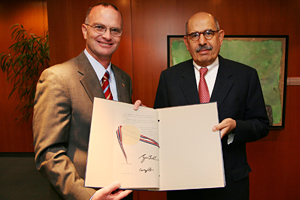US Additional Protocol enters into force
09 January 2009
The USA has completed ratification procedures, allowing the Additional Protocol (AP) of the Nuclear Non-Proliferation Treaty (NPT) to enter into force.
 |
| Head of the IAEA, Mohamed ElBaradei, is handed the documentation by US Ambassador Gregory Schulte (Image: IAEA) |
The AP is a legal document granting the IAEA complementary inspection authority to that provided in underlying safeguards agreements which aim to prevent the spread of nuclear weapons materials, technology and skills.
A principal aim is to enable the IAEA inspectorate to provide assurance about both declared and possible undeclared activities. Under the protocol, the IAEA is granted expanded rights of access to information and sites. In the case of the USA as a recognised holder of nuclear weapons this is largely symbolic, the primary purpose of safeguards being to prevent the illicit development of nuclear arms.
The USA signed the AP in 1998. President George Bush ratified the Additional Protocol at the end of December 2008. A letter from the President, which certified that changes in US procedures would be in place within 180 days, was submitted to officials, Congressmen and Senators on 30 December.
US ambassador Gregory Schulte formally handed over the notification of the USA's ratification procedures to IAEA Director General Mohamed ElBaradei on 6 January, marking the effective date for the entry into force for the AP for the country.
In a statement, the IAEA said: "With the entry into force of the US AP, all five nuclear-weapon states party to the NPT have fulfilled their undertaking, assumed at the time of approval by the IAEA board of governors of the Model Additional Protocol in 1997, to conclude such agreements."
To date, 118 countries have signed an Additional Protocol with the IAEA and 89 countries have ratified it.